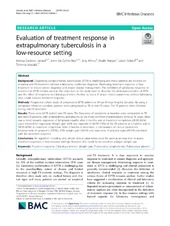| dc.contributor.author | Jørstad, Melissa Davidsen | en_US |
| dc.contributor.author | Dyrhol-Riise, Anne Ma | en_US |
| dc.contributor.author | Aßmus, Jörg | en_US |
| dc.contributor.author | Marijani, Msafiri | en_US |
| dc.contributor.author | Sviland, Lisbeth | en_US |
| dc.contributor.author | Mustafa, Tehmina | en_US |
| dc.date.accessioned | 2019-11-27T17:04:58Z | |
| dc.date.available | 2019-11-27T17:04:58Z | |
| dc.date.issued | 2019-05-16 | |
| dc.Published | Jørstad MD, Dyrhol-Riise AM, Aßmus J, Marijani M, Sviland L, Mustafa T, Mustafa. Evaluation of treatment response in extrapulmonary tuberculosis in a low-resource setting. BMC Infectious Diseases. 2019;19:426 | eng |
| dc.identifier.issn | 1471-2334 | |
| dc.identifier.uri | https://hdl.handle.net/1956/21037 | |
| dc.description.abstract | Background Diagnosing extrapulmonary tuberculosis (EPTB) is challenging and many patients are initiated on empirical anti-TB treatment without a laboratory confirmed diagnosis. Monitoring treatment response is thus important to ensure correct diagnosis and proper disease management. The definition of satisfactory response to treatment in EPTB remains unclear. The objectives of this study were to describe the clinical presentation of EPTB and the effect of treatment on clinical parameters. Further, to assess if simple clinical parameters, without laboratory data, could evaluate treatment response. Methods Prospective cohort study of presumptive EPTB patients at Mnazi Mmoja Hospital, Zanzibar. By using a composite reference standard, patients were categorized as TB or non-TB cases. The TB patients were followed during anti-TB treatment. Results There were 64 TB and 62 non-TB cases. The frequency of symptoms at baseline were comparable in TB and non-TB patients, with lymphadenitis and pleuritis as the most common manifestations. Among TB cases, there was a trend towards regression of lymphadenopathy after 2 months, and at treatment completion 24/28 (86%) cases showed full regression. Weight gain ≥5% was reported in 36/49 (73%) of the TB patients at 2 months and in 38/46 (83%) at treatment completion. After 2 months of treatment, a combination of clinical parameters; improvement of symptoms (50/50), ≥5% weight gain (36/49) and regression of physical signs (45/49) correlated with the treatment response. Conclusions An algorithm including only simple clinical parameters could be used as an easy tool to assess treatment responses in low-resource settings. However, this needs to be tested on a larger sample size. | en_US |
| dc.language.iso | eng | eng |
| dc.publisher | BMC | eng |
| dc.rights | Attribution CC BY | eng |
| dc.rights.uri | http://creativecommons.org/licenses/by/4.0/ | eng |
| dc.subject | Treatment outcome | eng |
| dc.subject | Clinical parameters | eng |
| dc.subject | Weight gain | eng |
| dc.subject | Tuberculous lymphadenitis | eng |
| dc.subject | Tuberculous pleuritis | eng |
| dc.title | Evaluation of treatment response in extrapulmonary tuberculosis in a low-resource setting | en_US |
| dc.type | Peer reviewed | |
| dc.type | Journal article | |
| dc.date.updated | 2019-09-28T15:44:29Z | |
| dc.description.version | publishedVersion | en_US |
| dc.rights.holder | Copyright 2019 The Authors | |
| dc.identifier.doi | https://doi.org/10.1186/s12879-019-4034-z | |
| dc.identifier.cristin | 1714355 | |
| dc.source.journal | BMC Infectious Diseases | |
| dc.relation.project | Norges forskningsråd: 234457 | |
| dc.subject.nsi | VDP::Medisinske fag: 700 | |
| dc.subject.nsi | VDP::Midical sciences: 700 | |

